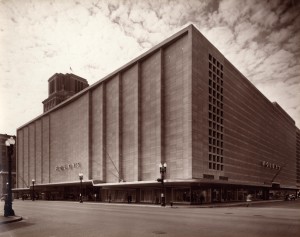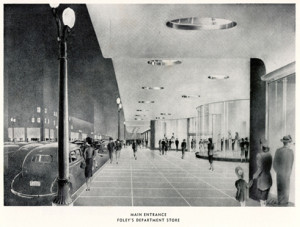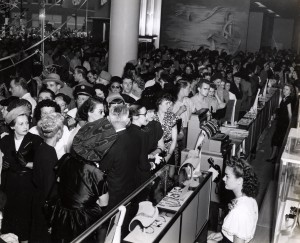
The following continues a series of contributions from Dr. Stephen James, who works with the Architecture and Planning collections here at the University of Houston Special Collections. Dr. James holds a Ph.D. in Architectural History from the University of Virginia and for many years was a lecturer at the University of Houston College of Architecture.
A part of Houston’s history disappeared last weekend. In the early morning hours of Sunday, September 22nd, demolition crews imploded the Macy’s building on Main Street in the downtown area. The building—until 2006 the flagship of the Foley’s department store chain—had not been an important part of Houston commerce and culture for many years. But its passing is another marker that requires us to look back, if only for a moment, at a time when Houston was a very different place than it is now.
The building’s grand opening in 1947 was a major event. With a population under 500,000, Houston was a much smaller city, and most people lived within a few miles of the downtown business district. There were no suburban shopping malls, and downtown was the focus for most shopping and entertainment. Citizens marveled at the new Foley’s building and welcomed the convenience of a large department store. Unlike smaller specialty retailers, Foley’s offered appliances, clothing, furniture, and many other items, all in one place. And what a place it was! With six floors of merchandise (later expanded to ten) covering an entire city block, it was enormous—a Texas-sized store for the state’s largest city. In keeping with the company’s ambitions to be the state’s premier retailer, Foley’s hired Kenneth Franzheim, one of the city’s leading architects, to design the new building. Air conditioning cooled the store’s shoppers while the fastest escalators sped them between floors.
In hindsight, Foley’s downtown store opened near the end of the era that spawned it. Less than a decade later, Houston began its explosive march to the suburbs. By the mid-1950s the opening of the city’s first automobile expressway, the Gulf Freeway, paved the way for Gulfgate, its first large suburban shopping mall. Others soon followed. And while the downtown store remained the flagship of a sprawling chain that catered to suburban shoppers, business dwindled downtown, as office workers and inner-city residents claimed the aisles.
Sadly, when the explosive charges brought down Franzheim’s massive store, the building had long outlived the business and social models that created it. The compact urban area focused on downtown was a quaint relic of an earlier day. It was time to move on in a city unable to embrace the future without first erasing its past.
The University of Houston preserves the history of the Foley’s building and the company that created it in the Foley’s Department Store Records, housed in Anderson Library’s Special Collections Department. The university’s William R. Jenkins Architecture and Art Library holds the Kenneth Franzheim Collection, which contains many of the architect’s drawings and papers. See also an earlier entry by Gregory Yerke in the Special Collections blog, “Foley’s and Houston: A Century of History”. For further information, researchers should consult Foley’s by Lasker M. Meyer (Charleston, S.C.: Arcadia Publishing, 2011).



Pingback: UH Libraries' Blogs | UH Libraries' News